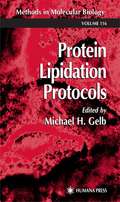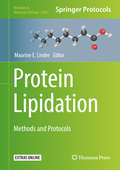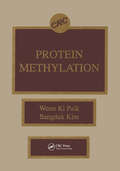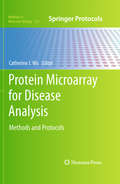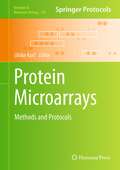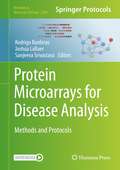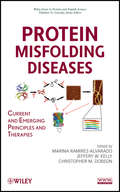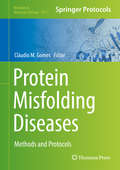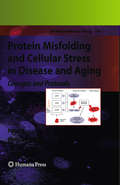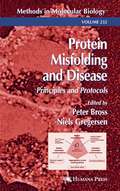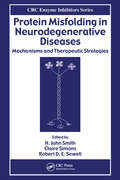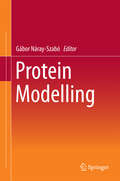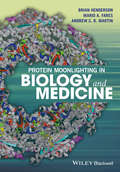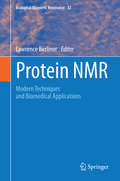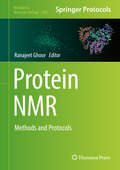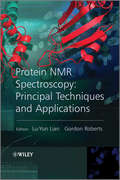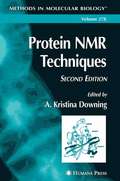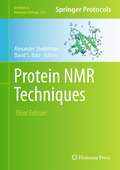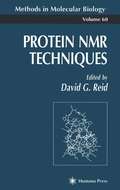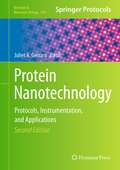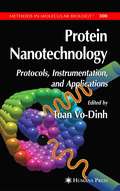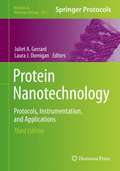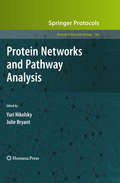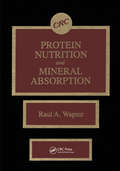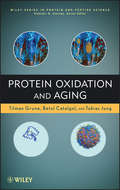- Table View
- List View
Protein Lipidation Protocols
by Michael H. GelbAn all-star collection of readily reproducible techniques for studying protein lipidation, the covalent attachment of lipids to proteins. These cutting-edge methods-many never published before in a "hands-on" format-deal with glycosyl phosphatidylinositol (GPI)-containing compounds, protein protein fatty acylation, and protein prenylation. Included are novel techniques for determining the chemical structure of GPI-anchors, for radiolabeling the prenyl groups of protein in eukaryotic cells, a tool for developing inhibitors of the protein farnesyltransferase, and for an exciting lysosomal enzyme that cleaves fatty acyl groups from proteins, the first fatty acylase discovered. Protein Lipidation Protocols offers biochemists, cell and molecular biologists, medicinal chemists, and pharmaceutical researchers state-of-the-art tools for understanding the complex biochemistry of protein lipidation.
Protein Lipidation: Methods and Protocols (Methods in Molecular Biology #2009)
by Maurine E. LinderThis volume explores techniques used to detect lipids attached to proteins, to analyze the function of lipid modifications, and to characterize the enzymes that add and remove lipids from proteins. The book is organized into seven parts: Part One describes chemically-based strategies to identify substrates for protein lipidation that can be applied to individual proteins or globally using proteomics. Part Two focuses on the enzymes that remove fatty acids from proteins and provides methods to monitor protein biogenesis and palmitate turnover. Part Three addresses biochemical and cellular characterization of DHHC S-acyltransferases, a family of enzymes with 23 members encoded by the human genome. Part Four presents the SwissPalm 2 database and tips on how to use it effectively. Part Five focuses on fatty acylation that occurs in the lumen of the secretory pathway. Parts Six and Seven conclude the book with methods to produce and assay lipid-modified and integral membrane proteins. Written in the highly successful Methods in Molecular Biology series format, chapters include introductions to their respective topics, lists of the necessary materials and reagents, step-by-step, readily reproducible laboratory protocols, and tips on troubleshooting and avoiding known pitfalls.Cutting-edge and authoritative, Protein Lipidation: Methods and Protocols is a valuable resource for experts in the field and for investigators who encounter protein lipidation through their research on a particular cellular process or favorite protein.
Protein Methylation
by Woon Ki Paik Sangduk KimThis significant volume provides reviews on protein methylation reactions which occur ubiquitously in nature. Written in a comprehensive style, this work covers knowledge on the natural occurrence of methylated amino acids, their chemical synthesis, plus the enzymology, biological regulator, and biological significance of free methylated amino acids. It also includes various specific biological systems where posttranslational methylation reactions have been demonstrated. This text is unique because the chapters are critically reviewed by authorities in each respective field. This well-written volume is an excellent reference to researchers as well as graduate students interested in post-synthetic modifications of macromolecules.
Protein Microarray for Disease Analysis
by Catherine J. WuProtein microarrays have been used for a wide variety of important tasks, such as identifying protein-protein interactions, discovering disease biomarkers, identifying DNA-binding specificity by protein variants, and for characterization of the humoral immune response. In Protein Microarray for Disease Analysis: Methods and Protocols, expert researchers provide concise descriptions of the methodologies currently used to fabricate microarrays for the comprehensive analysis of proteins or responses to proteins that can be used to dissect human disease. These methodologies are the toolbox for revolutionizing drug development and cell-level biochemical understanding of human disease processes. Beginning with a section on protein-detecting analytical microarrays, the volume continues with sections covering antigen microarrays for immunoprofiling, protein function microarrays, the validation of candidate targets, proteomic libraries, as well as signal detection strategies and data analysis techniques. Written in the highly successful Methods in Molecular BiologyTM series format, chapters include introductions to their respective topics, lists of the necessary materials and reagents, step-by-step, readily reproducible laboratory protocols, and key tips on troubleshooting and avoiding known pitfalls. Practical and cutting-edge, Protein Microarray for Disease Analysis: Methods and Protocols serves as a solid framework to aid scientists in understanding how protein microarray technology is presently developing and how it can be applied to transform our analysis of human disease.
Protein Microarrays
by Ulrike KorfProgress in functional proteomics has been limited for a long time, partially caused by limitations in assay sensitivity and sample capacity; however, protein microarrays have the ability to overcome these limitations so that a highly parallel analysis of hundreds of proteins in thousands of samples is attainable. In Protein Microarrays: Methods and Protocols, expert researchers in the field present an up-to-date collection of robust strategies in the field of protein microarrays and summarize recent advantages in the field of printing technologies, the development of suitable surface materials, as well as detection and quantification technologies. Written in the highly successful Methods in Molecular BiologyTM series format, chapters include introductions to their respective topics, lists of the necessary materials and reagents, step-by-step, readily reproducible laboratory protocols, and key notes on troubleshooting and avoiding known pitfalls. Comprehensive and cutting-edge, Protein Microarrays: Methods and Protocols aims to stimulate the application and further advancement of this powerful technology in labs worldwide.
Protein Microarrays for Disease Analysis: Methods and Protocols (Methods in Molecular Biology #2344)
by Sanjeeva Srivastava Rodrigo Barderas Joshua LaBaerThis volume focuses on protein analysis, and covers a wide array of uses of protein microarray for disease analysis. The chapters in this book discuss different stages of protein microarrays from their construction to their use, including different types of protein microarrays such as recombinant proteins, antibody, phage, and NAPPA protein microarrays, in planar format or in solution via beads arrays. Written in the highly successful Methods in Molecular Biology series format, chapters include introductions to their respective topics, lists of the necessary materials and reagents, step-by-step, readily reproducible laboratory protocols, and tips on troubleshooting and avoiding known pitfalls.Comprehensive and cutting-edge, Protein Microarrays for Disease Analysis: Methods and Protocols is a valuable resource for graduate and post-doctoral fellows interested in protein microarrays, as well as senior researchers interested in gaining more insight into this developing field.
Protein Misfolding Diseases: Current and Emerging Principles and Therapies (Wiley Series in Protein and Peptide Science #14)
by Marina Ramirez-Alvarado Jeffery W. Kelly Christopher M. DobsonAn increasingly aging population will add to the number of individuals suffering from amyloid. Protein Misfolding Diseases provides a systematic overview of the current and emerging therapies for these types of protein misfolding diseases, including Alzheimer's, Parkinson's, and Mad Cow. The book emphasizes therapeutics in an amyloid disease context to help students, faculty, scientific researchers, and doctors working with protein misfolding diseases bridge the gap between basic science and pharmaceutical applications to protein misfolding disease.
Protein Misfolding Diseases: Methods and Protocols (Methods in Molecular Biology #1873)
by Cláudio M. GomesThis detailed book gathers a broad collection of experimental approaches to assist researchers in setting up different methods to investigate protein conformational disorders. Beginning with a section on assays focusing on biophysical approaches to study protein (mis)folding, the volume continues with sections on cellular and proteostasis assays as well as assays for protein folding correction and recovery, combining methods such as thermal shift assays, in silico improvement of protein solubility, and compound screening, an important area of research as it may open avenues for therapeutic strategies. Written for the highly successful Methods in Molecular Biology series, chapters include introductions to their respective topics, lists of the necessary materials and reagents, step-by-step, readily reproducible laboratory protocols, and tips for troubleshooting and avoiding known pitfalls. Authoritative and practical, Protein Misfolding Diseases: Methods and Protocols serves as an ideal guide for researchers seeking to advance our knowledge of protein conformational disorders.
Protein Misfolding and Cellular Stress in Disease and Aging
by Niels Gregersen Peter BrossHow and why certain proteins misfold and how this misfolding is linked to many disease processes has become a well-documented topic of study. Protein Misfolding and Cellular Stress in Disease and Aging: Concepts and Protocols moves beyond the basics to emphasize the molecular effects of protein misfolding at a cellular level, to delineate the impacts and cellular reactions that play a role in pathogenetic mechanisms, and to pinpoint possible manipulations and treatment strategies that can counteract, modify, or delay the consequences of misfolding. The volume begins with several concepts and approaches developed in the recent past including a connection to the research field of aging, where protein misfolding diseases have been equated to premature aging processes, and the book's coverage continues with detailed descriptions of protocols for relevant experimental approaches. Written in the highly successful Methods in Molecular BiologyTM series format, protocols chapters include introductions to their respective topics, lists of the necessary materials and reagents, step-by-step, readily reproducible laboratory protocols, and tips on troubleshooting and avoiding known pitfalls. Authoritative and cutting-edge, Protein Misfolding and Cellular Stress in Disease and Aging: Concepts and Protocols aims to aid researchers in the field, as well as medical professionals and molecular biologists, in shaping and performing research related to this intriguing and vital subject.
Protein Misfolding and Disease
by Niels Gregersen Peter BrossA comprehensive review of the latest thinking about the molecular processes underlying conformational diseases, combined with a remarkable set of biochemical, genomic cellular, and chemical laboratory techniques for studying their genesis and pathologies. The authors apply their carefully refined methods to a variety of metabolic and neurodegenerative disorders, as well as to the aging process. The techniques presented are broadly applicable in many diverse disease contexts and may be used in both diagnosis and research on new treatment strategies.
Protein Misfolding in Neurodegenerative Diseases: Mechanisms and Therapeutic Strategies
by H. John Smith Claire Simons Robert D. E. SewellCurrent research suggests that neurodegenerative diseases such as Alzheimer's, Parkinson's, Huntington's, and Creutzfeldt-Jacob may be linked to disorders in protein shape referred to as protein misfolding. Continued study in this area could lead to promising advances in future treatment of these diseases. This groundbreaking text describes the latest findings regarding protein misfolding in the context of it being a marker, and perhaps a cause, in neurodegenerative diseases. Comprehensive coverage includes the diverse biochemical targets/markers for each disease, the currently limited success of drug therapies, and the cutting-edge research that could lead to more promising treatments.
Protein Modelling
by Gábor Náray-SzabóIn this volume, a detailed description of cutting-edge computational methods applied to protein modeling as well as specific applications are presented. Chapters include: the application of Car-Parrinello techniques to enzyme mechanisms, the outline and application of QM/MM methods, polarizable force fields, recent methods of ligand docking, molecular dynamics related to NMR spectroscopy, computer optimization of absorption, distribution, metabolism and excretion extended by toxicity for drugs, enzyme design and bioinformatics applied to protein structure prediction. A keen emphasis is laid on the clear presentation of complex concepts, since the book is primarily aimed at Ph. D. students, who need an insight in up-to-date protein modeling. The inclusion of descriptive, color figures will allow the reader to get a pictorial representation of complicated structural issues.
Protein Moonlighting in Biology and Medicine
by Brian Henderson Andrew C. Martin Mario A. FaresThe past 25 years has seen the emergence of a wealth of data suggesting that novel biological functions of known proteins play important roles in biology and medicine. This ability of proteins to exhibit more than one unique biological activity is known as protein moonlighting. Moonlighting proteins can exhibit novel biological functions, thus extending the function of the proteome, and are also implicated in the pathology of a growing number of idiopathic and infectious diseases. This book, written by a cell biologist, protein evolutionary biologist and protein bioinformatician, brings together the latest information on the structure, evolution and biological function of the growing numbers of moonlighting proteins that have been identified, and their roles in human health and disease. This information is revealing the enormous importance protein moonlighting plays in the maintenance of human health and in the induction of disease pathology. Protein Moonlighting in Biology and Medicine will be of interest to a general readership in the biological and biomedical research community.
Protein NMR
by Lawrence BerlinerThis book covers new techniques in protein NMR, from basic principles to state-of-the-art research. It covers a spectrum of topics ranging from a "toolbox" for how sequence-specific resonance assignments can be obtained using a suite of 2D and 3D NMR experiments and tips on how overlap problems can be overcome. Further topics include the novel applications of Overhauser dynamic nuclear polarization methods (DNP), assessing protein structure, and aspects of solid-state NMR of macroscopically aligned membrane proteins. This book is an ideal resource for students and researchers in the fields of biochemistry, chemistry, and pharmacology and NMR physics. Comprehensive and intuitively structured, this book examines protein NMR and new novel applications that include the latest technological advances. This book also has the features of: * A selection of various applications and cutting-edge advances, such as novel applications of Overhauser dynamic nuclear polarization methods (DNP) and a suite of 2D and 3D NMR experiments and tips on how overlap problems can be overcome * A pedagogical approach to the methodology * Engaging the reader and student with a clear, yet critical presentation of the applications
Protein NMR
by Ranajeet GhoseThis volume covers state-of-the-art applications of solid-state and solution nuclear magnetic resonance( NMR) spectroscopy to study protein structure, dynamics and interactions. Chapters detail various aspects of data acquisition and processing, determination of the structure, multi-timescale dynamics of entities ranging from individual proteins to large macromolecular complexes to intact viral assemblies. The final two chapters will highlight the promise of NMR beyond field strengths of 1 GHz to study the structure, dynamics and interactions of a larger class of proteins and protein complexes of extraordinary biological interest. Written in the highly successful Methods in Molecular Biology series format, chapters provide detailed laboratory protocols and troubleshooting tips that would be of great practical help to NMR spectroscopists with different levels of expertise. Authoritative and cutting-edge, Protein NMR: Methods and Protocol aims to ensure successful results in the further study of this vital field.
Protein NMR Spectroscopy
by Gordon Roberts Lu-Yun LianNuclear Magnetic Resonance (NMR) spectroscopy, a physical phenomenon based upon the magnetic properties of certain atomic nuclei, has found a wide range of applications in life sciences over recent decades. The dramatic advances in NMR techniques have led to corresponding advances in the ability of NMR to study structure, dynamics and interactions of biological macromolecules in solution under close to physiological conditions. This volume focuses on the use of NMR to study proteins.NMR can be used to determine detailed three-dimensional structures of proteins in solution. Furthermore, it provides information about conformational or chemical exchange, internal mobility and dynamics at timescales varying from pcoseconds to seconds. It is the primary technique used to obtain information on intrinsically disordered (unfolded) proteins, since these proteins will not crystallize easily. NMR is also a very powerful method for the study of interactions of protein with other molecules, whether small molecules (including drugs), nuclear acids or other proteins.This up-to-date volume covers NMR techiniques and their application to proteins, with a focus on practical details. This book will provide a newcomer to NMR with the practical guidance in order to carry out successful experiments with proteins and to analyze the resulting spectra. Those who are familiar with the chemical applications of NMR will also find is useful in understanding the special requirements of protien NMR.
Protein NMR Techniques
by A. Kristina DowningThis collection of readily reproducible methods using the latest advances in NMR technology includes methods for high-level recombinant protein expression using sophisticated isotopic labeling strategies, TROSY methods for the study of structure and dynamics, and methods for the acquisition and interpretation of residual dipolar coupling data. There are also applications of dynamics measurements on multiple timescales, new developments in NMR data analysis, structure calculation protocols, and solid-state methods. The protocols follow the successful Methods in Molecular BiologyTM series format, each offering detailed laboratory instructions, an introduction outlining the principle behind the technique, lists of equipment and reagents, and tips on troubleshooting and avoiding known pitfalls.
Protein NMR Techniques
by Alexander Shekhtman David S. BurzThe field of protein NMR spectroscopy has rapidly expanded into new areas of biochemistry, molecular biology and cell biology research that were impossible to study as recently as ten years ago. This third edition of Protein NMR Techniques, expands upon the previous editions with current, detailed authoritative but down-to-earth descriptions of new methodologies. These include techniques for NMR sample preparation, solution and solid state NMR methodologies and data processing. Written in the highly successful Methods in Molecular BiologyTM series format, chapters include introductions to their respective topics, lists of the necessary materials and reagents, step-by-step, readily reproducible laboratory protocols, and key tips on troubleshooting and avoiding known pitfalls. Authoritative and practical, Protein NMR Techniques,Third Edition, seeks to aid scientists in understanding the latest innovations in the field of protein NMR.
Protein NMR Techniques
by David G. ReidLeading experts demonstrate how to successfully apply the fundamentals of NMR to the study of the properties of proteins. They cover not only assignment and structure determination techniques, but also the practical aspects of experimental set-up, protein production, data processing, and binding studies. Extensive treatments of paramagnetics and metalloproteins, membrane-bound proteins, and protein-ligand complexes are also included. Its focused treatment of proteins make it an indispensable study guide for chemists and biochemists, including both those with only a basic knowledge of NMR, as well as more experienced investigators.
Protein Nanotechnology
by Juliet A. GerrardSince the first edition of Protein Nanotechnology Protocols Instruments and Applications the intersection of protein science and nanotechnology has become an exciting frontier in interdisciplinary sciences. The second edition of Protein Nanotechnology Protocols Instruments and Applications expands upon the previous editions with current, detailed chapters that provide examples of proteins which are now being harnessed for a wide range of applications, some more developed than others. This book also delves into engineering proteins and an overview of the sorts of tools that are now readily available to manipulate the structure and function of proteins, both rationally and using methods inspired by evolution. Written in the highly successful Methods in Molecular BiologyTM series format, chapters include introductions to their respective topics, lists of the necessary materials and reagents, step-by-step, readily reproducible laboratory protocols, and key tips on troubleshooting and avoiding known pitfalls. Authoritative and practical, Protein Nanotechnology Protocols Instruments and Applications, Second Edition seeks to provide an overview of this multi-faceted field and a useful guide to those who wish to contribute to it.
Protein Nanotechnology
by Tuan Vo-DinhLeading experts in nanobiotechnology comprehensively review the most recent advances in instrumentation and methodology, as well as their applications in genomics and proteomics. The authors provide a wide variety of techniques and methods for dealing with protein functions and structures at the nanoscale level, including nanostructured systems, nanomaterials, carbon nanotubes and nanowires, optical nanosensors, and nanoelectrodes. Among the highlights are techniques for the in vivo tracking of biochemical processes using fluorescent molecular probes and nanosensors, and the exploration of biochemical processes and submicroscopic structures of living cells at unprecedented resolutions using near-field optics. Also discussed is the development of nanocarrier methodology for the targeted delivery of drugs whose shells are conjugated with antibodies for targeting specific antigens.
Protein Nanotechnology: Protocols, Instrumentation, and Applications (Methods in Molecular Biology #2073)
by Juliet A. Gerrard Laura J. DomiganThis third edition volume expands on the previous editions with updated approaches and techniques used to study protein nanotechnology and the future of nanomaterial compositions. This book is organized into Three Parts: Part One looks at recombinant protein expression in insect cells, and methods to produce molecular motors, molecular superglues, and protein templates; Part Two explores functionalization strategies and ways to incorporate functional protein components into nanodevices; Part Three discusses various instrumental techniques used to study protein nanostructures. Written in the highly successful Methods in Molecular Biology series format, chapters include introductions to their respective topics, lists of the necessary materials and reagents, step-by-step, readily reproducible laboratory protocols, and tips on troubleshooting and avoiding known pitfalls. Cutting-edge and thorough, Protein Nanotechnology: Protocols, Instrumentation, and Applications, Third Edition is a valuable resource for any researchers looking to expand their knowledge in this evolving field.
Protein Networks and Pathway Analysis
by Julie Bryant Yuri NikolskyFrom the beginning of the OMICs biology era, science has been pursuing the reduction of the complex "genome-wide" assays in order to understand the essential biology that lies beneath it. In Protein Networks and Pathway Analysis, expert practitioners present a compilation of methods of functional data analysis, often referred to as "systems biology," and its applications in drug discovery, medicine and basic disease research. The volume is divided into three convenient sections, covering the elucidation of protein, compound and gene interactions, analytical tools, including networks, interactome and ontologies, and applications of functional analysis. As a volume in the highly successful Methods in Molecular BiologyTM series, this work provides detailed descriptions and hands-on implementation advice. Authoritative and cutting-edge, Protein Networks and Pathway Analysis presents both "wet lab" experimental methods and computational tools in order to cover a broad spectrum of issues in this fascinating new field.
Protein Nutrition and Mineral Absorption
by Raul A. WapnirThis volume presents information regarding the mechanisms of protein absorption under normal and pathologic conditions, in addition to reviewing changes that occur at various stages of life. General modifiers of intestinal absorption, such as the processing of foods, the nutritional status of the individual, and disease, are explored with reference to both proteins and minerals. Inorganic macronutrients, namely calcium, magnesium and phosphorus, are discussed in relation to protein ingestion. The book also explores the concept of essential trace elements (e.g., iron, zinc, copper, and iodine) and their link to protein sufficiency. The relationship of ultratrace elements with the content of proteins in food is examined, and the book offers a fresh view of the role of certain elements, particularly zinc, on the conformation of proteins linked to DNA, hormone receptors, and gene products. Protein Nutrition and Mineral Absorption is packed with 2,300 references, 100 figures and graphs, plus 25 tables. Nutritionists and physicians will find this book to be an invaluable reference source for rationalizing nutritional interventions and diet modifications for their patients.
Protein Oxidation and Aging
by Vladimir Uversky Tilman Grune Tobias Jung Betul CatalgolReviews our current understanding of the role of protein oxidation in aging and age-related diseasesProtein oxidation is at the core of the aging process. Setting forth a variety of new methods and approaches, this book helps researchers conveniently by exploring the aging process and developing more effective therapies to prevent or treat age-related diseases. There have been many studies dedicated to the relationship between protein oxidation and age-related pathology; now it is possible for researchers and readers to learn new techniques as utilizing protein oxidation products as biomarkers for aging.Protein Oxidation and Aging begins with a description of the tremendous variety of protein oxidation products. Furthermore, it covers:Major aspects of the protein oxidation processCellular mechanisms for managing oxidized proteinsRole of protein oxidation in agingInfluence of genetic and environmental factors on protein oxidationMeasuring protein oxidation in the aging processProtein oxidation in age-related diseasesReferences at the end of each chapter serve as a gateway to the growing body of original research studies and reviews in the field.
